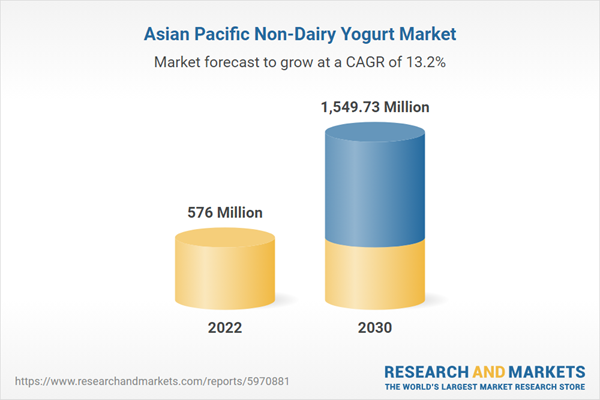Strategic Development Initiatives by Manufacturers Fuels the Asia Pacific Non-Dairy Yogurt Market
Non-dairy yogurt manufacturers are making significant investments in product innovations to attract a large group of consumers. The manufacturers offer certified organic, non-GMO, gluten-free, clean-label, and allergen-free products to cater to emerging customer requirements. Moreover, as consumers have become health-conscious, they prefer low-calorie and low-fat products. Therefore, manufacturers of plant-based dairy offer unsweetened and low-sugar products. In February 2021, Halsa Foods launched zero-sugar oat milk yogurt in a 24 oz family size. The product contains only 90 calories per serving and has no added sugar. Also, in 2023, Yoghurt brand Coyo Pty Ltd has launched a new range of plant-based frozen yoghurt made with real fruit, and using coconut as its yoghurt base, in place of dairy.Further, manufacturers are also launching products by incorporating different flavors and functional nutrients. In December 2020, Danone SA launched the Silk Kids Almond Milk Yogurt Alternative plant-based yogurts, specially formulated for kids. The product comprises fava beans protein, almond milk, live & active culture, and organic coconut oil. It is fortified with vitamin D and calcium to satisfy the children's nutrition. The yogurt substitute is dairy-free, lactose-free, gluten-free, and peanut-free. It is available in three flavors-apple cinnamon, strawberry, and mixed berry. Product innovation strategy offers a competitive edge to the players operating in the market and boosts their profitability, which propels the Asia Pacific non-dairy yogurt market growth.
Asia Pacific Non-Dairy Yogurt Market Overview
The non-dairy yogurt market in the Asia Pacific is segmented into Australia, China, India, Japan, South Korea, and the Rest of Asia Pacific. A few factors contributing to the demand for non-dairy yogurt in the region are a surge in health-conscious consumers in emerging countries and the rising trend of consuming plant-based dairy products. Non-dairy yogurts contain low-fat, low-calorie, and low-cholesterol content, appealing to health-conscious and lactose-intolerant customers. Moreover, a few people are vegan, while an increasing number of people are adopting"flexitarian" dietary patterns. Thus, this shift in customer preferences boosts the demand for dairy alternatives such as non-dairy yogurt.In recent years, the consumption of non-dairy yogurt has steadily increased due to the growing number of lactose-intolerant people and health concerns regarding antibiotics and growth hormones often found in cows milk. The research conducted by Rakuten in 2021 showed that 87% of consumers in China had tried plant-based milk, 50% had tried other dairy substitutes, 42% had tried plant-based meat, and 32% had tried vegan egg replacements. Furthermore, the same research found that 3% of respondents only consume plant-based foods.
The non-dairy yogurt market in the Asia Pacific is significantly growing due to changing lifestyles of consumers and an increase in the consumption of clean-label products, organic, and gluten-free products. The market in the region is also undergoing a remarkable transformation due to increased urbanization, diet diversification, and the legalization of foreign direct investment in the food sector. Hence, manufacturers are adopting strategies for the development and expansion of their businesses. In 2020 Invigorate Foods announced its plan to invest US$ 8.4 million (INR 60 crores) in the next three years in plant, equipment, and other capital goods required for manufacturing soymilk products in India. Further, in 2019, The Blue Diamond announced its expansion into the non-dairy yogurt alternative category with almond breeze and almond milk yogurt alternatives. Similarly, food wholesaler and manufacturer Kokubu Food launched Japan's first almond-based yogurt in April 2020. Such developments by manufacturers boost the demand for non-dairy yogurt in Asia Pacific.
Asia Pacific Non-Dairy Yogurt Market Segmentation
The Asia Pacific non-dairy yogurt market is segmented based on source, type, nature, and distribution channel.Based on source, the Asia Pacific non-dairy yogurt market is segmented into almond, soy, coconut, oat, and others. The coconut segment held the largest share in 2022.
Based on type, the Asia Pacific non-dairy yogurt market is bifurcated into flavored and plain. The flavored segment held a larger share in 2022.
Based on nature, the Asia Pacific non-dairy yogurt market is bifurcated into organic and conventional. The conventional segment held a larger share in 2022.
Based on distribution channel, the Asia Pacific non-dairy yogurt market is segmented into supermarkets & hypermarkets, convenience stores, online retail, and others. The supermarkets & hypermarkets segment held the largest share in 2022.
Based on country, the Asia Pacific non-dairy yogurt market is categorized into Australia, China, India, Japan, South Korea, and the Rest of Asia Pacific. The Rest of Asia Pacific dominated the Asia Pacific non-dairy yogurt market in 2022.
The Hain Celestial Group Inc, Danone SA, COYO Pty Ltd, Valio Ltd, and Oatly Group AB are some of the leading companies operating in the Asia Pacific non-dairy yogurt market.
Table of Contents
Companies Mentioned
- The Hain Celestial Group Inc
- Danone SA
- COYO Pty Ltd
- Valio Ltd
- Oatly Group AB
Table Information
| Report Attribute | Details |
|---|---|
| No. of Pages | 84 |
| Published | March 2024 |
| Forecast Period | 2022 - 2030 |
| Estimated Market Value in 2022 | 576 Million |
| Forecasted Market Value by 2030 | 1549.73 Million |
| Compound Annual Growth Rate | 13.2% |
| Regions Covered | Asia Pacific |
| No. of Companies Mentioned | 5 |









